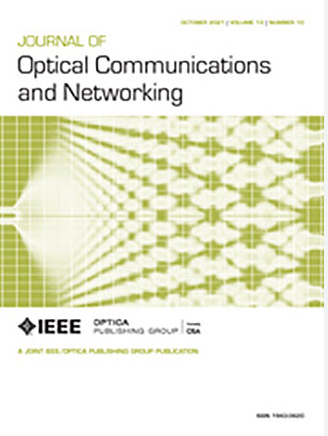Demonstration of a multi-technology 6G transport network integrating THz and optical network technologies empowered by federated learning
IF 4.3
2区 计算机科学
Q1 COMPUTER SCIENCE, HARDWARE & ARCHITECTURE
引用次数: 0
Abstract
This paper proposes a 6G architecture that adopts a multi-technology transport network integrating THz links and optical network technologies to interconnect the 6G radio access network and core domains. The proposed solution operates in a self-organized manner, taking advantage of the software defined networking (SDN) control of the optical network, while suitable SDN control is purposely developed for the THz solution. An end-to-end (E2E) Service Management and Orchestration (SMO) layer is adopted, offering intelligence capabilities in service provisioning and resource allocation across the 6G infrastructure through the adoption of a federated learning (FL) scheme. The proposed architecture and the developed control scheme are validated through an experimental demonstration. To the best of the authors’ knowledge, this is the first experimental demonstration of an autonomously controlled 6G network implementation integrating optical network technologies and THz links in a common transport network. The developed intelligent management framework empowered by FL to jointly optimize THz and multi-vendor optical network equipment supporting 6G services is also experimentally showcased.演示一个多技术6G传输网络,该网络集成了通过联邦学习授权的太赫兹和光网络技术
本文提出了一种6G架构,采用融合太赫兹链路与光网络技术的多技术传输网络,实现6G无线接入网与核心域的互联。提出的解决方案以自组织的方式运行,利用了光网络的软件定义网络(SDN)控制,而专门为太赫兹解决方案开发了合适的SDN控制。采用端到端(E2E)服务管理和编排(SMO)层,通过采用联邦学习(FL)方案,在6G基础设施中提供服务供应和资源分配方面的智能功能。通过实验验证了所提出的结构和所开发的控制方案。据作者所知,这是在公共传输网络中集成光网络技术和太赫兹链路的自主控制6G网络实现的第一次实验演示。由FL授权开发的智能管理框架,用于联合优化支持6G业务的太赫兹和多厂商光网络设备,并进行了实验展示。
本文章由计算机程序翻译,如有差异,请以英文原文为准。
求助全文
约1分钟内获得全文
求助全文
来源期刊
CiteScore
9.40
自引率
16.00%
发文量
104
审稿时长
4 months
期刊介绍:
The scope of the Journal includes advances in the state-of-the-art of optical networking science, technology, and engineering. Both theoretical contributions (including new techniques, concepts, analyses, and economic studies) and practical contributions (including optical networking experiments, prototypes, and new applications) are encouraged. Subareas of interest include the architecture and design of optical networks, optical network survivability and security, software-defined optical networking, elastic optical networks, data and control plane advances, network management related innovation, and optical access networks. Enabling technologies and their applications are suitable topics only if the results are shown to directly impact optical networking beyond simple point-to-point networks.

 求助内容:
求助内容: 应助结果提醒方式:
应助结果提醒方式:


